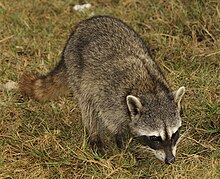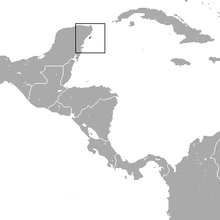Procyon pygmaeus
| Cozumel raccoon | |
|---|---|
 |
|
| Scientific classification | |
| Kingdom: | Animalia |
| Phylum: | Chordata |
| Class: | Mammalia |
| Order: | Carnivora |
| Family: | Procyonidae |
| Genus: | Procyon |
| Species: | P. pygmaeus |
| Binomial name | |
|
Procyon pygmaeus (Merriam, 1901) |
|
 |
|
| Cozumel raccoon range | |
The Cozumel raccoon (Procyon pygmaeus), also called the pygmy raccoon, is a critically endangered species of island raccoon endemic on Cozumel Island off the coast of the Yucatan Peninsula, Mexico.
The Cozumel raccoon goes by a variety of common names including the dwarf raccoon, Cozumel Island raccoon, and Cozumel raccoon-bear.
Clinton Hart Merriam first described the Cozumel raccoon as morphologically distinctive from its mainland relative, the common raccoon subspecies Procyon lotor hernandezii, in 1901. Since then, other scientists have generally agreed with Merriam's assessment, especially Kristofer Helgen and Don E. Wilson, who have dismissed this classification for the other four island raccoons in their studies in 2003 and 2005. Therefore, the Cozumel raccoon was listed as the only distinct species of the genus Procyon besides the common raccoon and the crab-eating raccoon in the third edition of Mammal Species of the World. An archaeological study showed that Maya from Cozumel used raccoons of reduced stature, which suggests that the size reduction of this raccoon is not a recent phenomenon.
No true fossils of the species are known, although skeletons have been found at some archeological sites on the island. Cozumel island itself separated from the mainland during the late , so that the species is unlikely to be older than 122,000 years. Data from molecular clock studies implies a divergence date from the common raccoon of anything between 26,000 and 69,000 years ago.
Merriam described the Cozumel raccoon as being markedly smaller, both externally and cranially and easy to distinguish from the common raccoon because of its "broad black throat band and golden yellow tail, short posteriorly expanded and rounded nasals and peculiarities of the teeth". Its reduced teeth point to a long period of isolation.
...
Wikipedia

